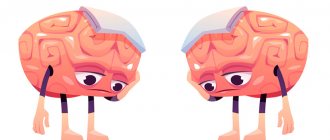Obsessive-compulsive disorder or, in other words, “obsessive neurosis” is a fairly common mental illness, which is a clear manifestation of borderline mental disorders. The approved medical name for this disease has two Latin roots: obsession and compulsion.
Obsession, translated from Latin, means “possession”, and in the aspect of this disease - an obsessive thought or idea. Obsessive thoughts of an OCD sufferer most often contain a scary, unhealthy and unpleasant idea in their content, and can also be aggressive in nature.
Compulsion is interpreted as an “obsessive action”, and according to its symptoms, it consists of permanent double-checking of everything: whether the door is closed, whether the appliances are turned off, whether hands have been thoroughly washed.
In simpler terms, OCD implies obsessions of any pathogenesis that literally prevent a person from living. Sick thoughts lead the patient to the need to constantly repeat the same actions, bringing the situation to the point of absurdity. For example, a patient with an internal fear of infection may “wash his hands” until he wipes them until they bleed. A patient with a compulsion to double-check may return home many times to check household appliances, or read the same page of a book a million times in an effort to find out how much time he spends on it. Of course, such a scheme of being reduces the quality of life, exhausts and torments a person, and ultimately leads to stressful conditions and neuroses.
We will look at how to live with this and what self-help methods you can use below in this article. In the meantime, let us pay attention to the etiology of the formation of this disease. What can serve as a trigger for the development of obsessive-compulsive syndrome.
What is obsessive-compulsive disorder?
Obsessive-compulsive disorder (OCD) is a disorder in which a person experiences recurring unwanted thoughts, obsessions, or urges to do something over and over again (compulsions).
Some people may have both obsessions and compulsions. OCD is not just habits like nail biting or occasional negative thoughts. A person with OCD may have intrusive thoughts, such as that certain numbers or colors are “good” or “bad.” An obsessive habit may be to wash your hands exactly seven times after touching something that is supposed to be dirty. Although a person with OCD may not want to follow through with their compulsions or want to get rid of the intrusive thoughts, they are nevertheless of an over-valued nature and they feel powerless to resist or stop.
Many people have habits or repetitive thoughts. However, in people with OCD they:
- Takes from one hour a day
- Not subject to voluntary control
- Doesn't give pleasure
- Affect work, relationships, social life
Self-help methods
In the previous paragraph, considering the behavior patterns of patients suffering from obsessive-compulsive neurosis, we classified the forms of the disorder into categories. Based on the nature of obsessions or compulsions, as well as background symptoms, the psychotherapeutic community recommends the following exercises:
The first and fairly common method is internal independent awareness of one’s sick thought (obsession) and recognition of it. The patient can say to himself: “Yes, this is my sick thought, which arose for a number of reasons that I need to neutralize.” How can you neutralize obsession? The awareness-acceptance technique involves an approach of the “knock out a wedge with a wedge” type, when it is proposed to turn your gaze inward and, through visualization, strengthen the situation that causes fear. If a person is afraid of dirt, then he needs to imagine that dirt is literally everywhere, and it is terrible. It is necessary to remain in this state for as long as possible, strengthening and thereby overcoming anxiety. The technique is used in the treatment of obsessions associated with fear of infection.
In a situation with contrasting obsessions and re-checking compulsions, psychotherapy offers a method of total acceptance of being. The patient is advised to imagine what will happen in the worst case scenario and accept it. For example, the iron is still on, which means the apartment will eventually burn down. In other words, you need to accept the finitude of any situation and its consequences.
Anything can happen, whether you think about it or not. The main thing is to be prepared for this.
The approach, by the way, is good in all other cases: whether a person is healthy or sick, whether he is treating neuroses and stress, or whether he feels quite comfortable. Accepting the existential theme that today may be the last day brings high awareness and brings us closer to accepting any circumstances.
Another great DIY method is keeping a journal of feelings and self-reflection, which is a simple way of working with yourself. It consists in the fact that a person writes down everything that happens to him: with whom he communicated, what he said, what he felt, what dreams he had. Details can be written down or drawn, whichever is more convenient for you. Thus, problems are brought into the field of conscious perception and, accordingly, independent control.
Types and symptoms of obsessive-compulsive disorder
OCD comes in many forms, but most cases fall into at least one of four general categories:
- Checks: for example, whether the lock is closed, whether the alarm system is on, whether the oven or switches are turned off; suspect the presence of any disorder or disease and check its diagnostic criteria.
- Contamination: Fear of things that may harbor bacteria/infections or a compulsion to clean. May include feeling like you are being treated like dirt.
- Symmetry and order: the need for everything to be arranged, lined up in a certain way.
- “Soap gum” and obsessive thinking: obsessive thoughts and thoughts. Some of them may be aggressive, violent, religious or disturbing in nature.
How exactly does compulsivity occur?
The nature of the occurrence of such actions has biological factors: genetically determined by the characteristics of the human body - hypersensitivity (hypersensitivity), and biochemical processes in the production of serotonin (the hormone of happiness).
There are socially determined factors in the occurrence of compulsive actions, namely:
- Traditions of teaching a child the rules of personal hygiene, demanding compliance with mandatory actions. The most common things from this period: strengthening of compulsive hand washing, intolerance to stains on clothes. Another example: the tradition of family dinners, the rituality of eating, even the skill of counting money in a wallet is formed at an early age under the influence of parental requirements.
- The desire to be like someone, to find an idol, or to identify oneself with member seven. If a person checks that the door is closed several times before going to bed, then most likely this habit will be passed on to his children.
Obsessive thoughts and compulsions
People with OCD usually realize that their thoughts and habits do not make sense. They spin these thoughts, follow the impulses, not because they like them, but because they cannot refuse them. And if they stop, people with OCD feel so bad that they start again.
Intrusive thoughts can often include:
- Concerns about yourself or others who have been or may be harmed
- Constantly checking blinking, breathing, or other bodily sensations
- Suspicion of a partner of infidelity, without reason.
Compulsive habits can often include:
- Doing tasks in a certain order every time or a certain “right” number of times
- The need to count, for example, steps or steps
- Fear of touching a doorknob, using a public restroom, or shaking another person's hand.
Manifestations of obsessions
Obsessions are expressed in various obsessive forms.
Actually, obsessive thoughts are single words, phrases, sentences, songs, poetic expressions of a negative nature that irritate and interfere with the patient.
- Impulses . A strong desire to commit an indecent act: while sitting at a meeting, an irresistible urge to yell at employees arises. Arriving at a restaurant, you suddenly want to hit the waiter. The urge to harm loved ones is considered common. There is a fear that the impulse will come true. In reality, persistent desires remain unfulfilled.
- Images . Unflattering scenes appear intrusively in a vivid form before a person’s eyes without his desire. Example: a man systematically has a picture of his friend being hit by a car popping up before his eyes.
- Doubts . They pop up against the background of an already accomplished event: did you lock the door, did you turn off the iron. A man, having worked his last working day, goes straight from work to the station. Here he will take the train and go to the sanatorium, where he will spend his vacation. On the way to the station, he begins to be tormented by doubts about whether he set the office alarm. I arrived at the station just as the train was leaving and had no opportunity to return and check the office. On the way to the sanatorium, the poor man already had a chain of tragic events: the office is located in a presentable area, in the city center. It has a convenient location, a balcony from which it is easy to get inside. There is a safe in the office. Surely the robbers found out that he was going on vacation, the office would be empty. For professionals, choosing a code for a safe is very simple. In the sanatorium he thinks only about work. Every day he checks the news to see if there are any reports of theft. Calls a colleague to find out how work is going. Exhausted by doubts, he returns from vacation ahead of schedule. On the road, the closer the patient gets to the house, the more anxiety and fear gripped him.
- Aggressive obsessions . Or contrasting thoughts relate to an unreasonable feeling of hatred towards relatives, towards any other person, object. Such antipathy is not supported by anything, it arises out of the blue. Patients do their best to drive away such feelings, understanding their irrationality. Example: the flaring up of negative feelings in a priest towards the saints. Aggressive obsessions are accompanied by a strong emotional outburst. There is a tireless desire to spoil any line with an unpleasant addition, to shout obscene, immoral phrases.
Imagery obsessions are classified as a separate group . These include obsessive thoughts and memories.
Intrusive thoughts are expressed in a long internal monologue on meaningless topics. A long chain of conclusions is born in the head, which does not lead to productive conclusions.
Such thoughts are so stupid that they are called “mental chewing gum”!
Fruitless obsessive reasoning within oneself is comparable to reasoning. The main difference is the patient’s critical attitude to his reasoning during obsessions.
A woman, walking down the street, thinks: who will I meet first among the passers-by, will it be a man or a woman? If a woman, what kind of haircut or long hair? Perhaps the first I will see is a man. Which direction will he go from? Such a series of questions/answers can continue for a long time in the patient’s head. Useless reasoning prevents you from focusing on significant events.
Intrusive memories force a person to systematically return mentally to a specific, already accomplished event that is insignificant or unpleasant.
Causes of obsessive-compulsive disorder and risk factors
There can be several causes of OCD. The disorder is very individual; to determine the causes, you need to consult a psychotherapist or medical psychologist. The following risk factors are identified:
- Family history: first degree relatives (father, mother, brother, sister, child) with OCD
- Depression, anxiety, anxiety, nervous tics
- Experience of psychological trauma
- Presence of psychological, physical or sexual abuse
- Neurological infections, brain injuries.
- Severe or chronic stress usually makes symptoms worse.
- OCD is more common in women than in men.
- Symptoms are more likely to appear in teenagers or young adults. However, OCD can also appear in adults as well as children, especially under severe or chronic stress.
Symptoms
OCD affects men, women and children equally. Race, nationality and other ethnographic characteristics of origin do not matter. OCD can begin at any time, from preschool to adulthood. Doctors distinguish two age ranges when the disease first appears. The first range falls between ages 8 and 12. The second range occurs between the late teenage years and early adulthood.
Scientists still do not know the exact cause of OCD. There is an assumption that everything depends on the structure of the brain and heredity:
- If we talk about the brain, then scientists see the problem in the disruption of communication between the front part of the brain and its deeper structures. Pictures were taken, and when OCD patients took medication, the brain circuits were partially restored and the person felt better.
- If we talk about genes, then they probably play a role in the development of the disorder: a relative suffered from OCD → harmful chromosomes got to the receiver → the receiver is at nine times the risk of developing OCD than an ordinary person. This conclusion was reached by an American research team that published its data in the Archives of General Psychiatry.
Almost nothing is known about the presence of other catalysts for the disease. These could be habitual illnesses and even normal life stresses that can trigger the activity of genes associated with OCD symptoms.
Symptoms of OCD in children
Parents should be alert to the following signs:
- Irritability
- Difficulty making decisions
- An inexplicable desire to be alone
- Refusal to communicate with friends
- Required to stay home or at school to complete assignments
- Excessive time spent on daily tasks, trouble sleeping
- Extreme reactions to minor changes in daily life
Children and adolescents are more likely to experience harm-related symptoms than adults. Typically, children obsessively ask adults to calm them down. They often crave routine and consistency. Only a qualified specialist can make a differential diagnosis, as well as suggest methods of correction or therapy.
Diagnosis of obsessive-compulsive disorder
Differential diagnosis is used to properly evaluate the disorder, taking into account the similarity of symptoms and possible overlap with other disorders. Differential diagnosis is a purely clinical assessment and is carried out only by appropriate specialists and in no case by the patient himself or his relatives. In addition to consulting a psychotherapist, a medical examination may be performed and blood tests may be prescribed to ensure that there are no other disorders or diseases that are causing the symptoms.
Treatment of obsessive-compulsive disorder
There is no single cure for OCD. A psychotherapist can use both non-drug methods of psychotherapy and prescribe pills, or use both approaches, depending on the symptoms in each specific case. Self-prescription of medications is unacceptable in order to avoid negative and unaccounted for side effects in the treatment plan and aggravation of the disorder.
Non-drug psychotherapeutic treatment may include cognitive behavioral psychotherapy, exposure psychotherapy, desensitization, relaxation techniques, or other non-drug psychotherapy methods as recommended by a psychotherapist or clinical psychologist. Medications may include antidepressants, anxiolytics, and in more complex cases, antipsychotic drugs. Neuromodulation and transcranial magnetic stimulation are used quite rarely.
Relationship between OCD and other disorders
Some individual disorders have symptoms similar to OCD. Obsessive-compulsive disorder (OCD) must be differentiated from the following disorders:
- Illness-related anxiety disorder: the presence of obsessions and/or compulsions that are attributable to the direct effects of physiological factors of a specific disease.
- Substance-induced anxiety disorder: the presence of obsessions and/or compulsions that are attributed to the use of drugs or certain medications.
- Dysmorphophobia (dysmorphic disorder): the content of obsessions and rituals is exclusively a concern for appearance.
- Social phobia or specific phobias: anxiety about a frightening situation, a frightening object, but not the content of obsessions.
- Trichotillomania: Ideas or repetitive rituals of pulling out one's own hair.
- Major depressive disorder: persistent rumination about unpleasant events accompanied by a negative state of mind and mood. They are not egodystonic ideas, that is, the person does not consider them foreign to him, unlike obsessive-compulsive disorder.
- Generalized anxiety disorder: There is increased anxiety (worry), which differs from obsessions in that the person experiences intense anxiety about real-life events (for example, losing a job). In addition, anxiety is experienced as self-generated (ego-synchronous).
- Hypochondriasis: recurring ideas due to fear of suffering, torment due to illness, provoked by misinterpretation of physical symptoms. There are usually no rituals such as washing out or excessive repetitions.
- Specific phobia of illness: there are no rituals either. The possibility of getting sick/infected is more concerning than the suffering from the disease itself.
- Delirium or undifferentiated somatoform disorder: Obsessions or compulsions dissociate from reality (for example, the belief that a person is responsible for the death of another person because he once wished for it). In addition, other psychotic symptoms are commonly observed.
- Schizophrenia: repeated illusions, delusions and stereotypical strange behavior that does not coincide with reality, egosyntonic mood. Sometimes both diagnoses coincide.
- Nervous tics or stereotypic movement disorder. Nervous tics (eg, clearing the throat, repetitive blinking movements) or stereotypic movements (eg, rocking, lip biting) are less complex than compulsions and are not aimed at eliminating the obsession. It is possible that symptoms of obsessive-compulsive disorder and tic disorder may co-occur and be diagnosed together.
- Formed and directed styles of behavior associated with other mental disorders: pathological gambling, paraphilia, eating disorders, alcohol addiction, etc. Repetitive thoughts and abuse of a certain form of behavior are noted, which relate respectively to gambling, sexual activity, food or alcohol, which cannot be considered obsessive, since the person derives pleasure from such behavior. If a person wants to get rid of harmful behavior patterns, it is solely due to the damage they cause.
- Non-pathological biases and repetitive behaviors: do not require a significant (excessive) investment of time and do not affect the person's daily activities. They also do not cause significant discomfort.
- Preoccupation with body odor: distorted odor perception, olfactory hallucinations.
Obsessions
Obsessions are born regardless of a person’s desire, appear suddenly, and it doesn’t matter what the patient is doing at the moment. They usually express thoughts about danger, harm, risk.
It’s difficult to get rid of “impudent” thoughts. They are difficult to control. By focusing on obsessions, the patient’s emotional state worsens. Anxiety increases, fear appears, depression and apathy develop. Patients become irritable. They are overtaken by a feeling of despair and powerlessness: well aware of the absurdity of the thoughts being born, they cannot cope with them.
The patient is depressed, self-doubt arises, and self-esteem decreases.
Emotional disturbances entail physiological disruption in the body. Physiological symptoms of the disorder are expressed as:
- headache, dizziness;
- tachycardia, shortness of breath;
- nausea;
- fainting;
- hyperhidrosis;
- digestive disorders;
- increased urination;
- pallor or hyperemia of the skin.
According to the mechanism of occurrence, obsessions are divided into elementary and cryptogenic.
Elementary obsessions are born immediately after the action of the defining impulse. Their reason is known. A doctor, in a conversation with a patient with hypertension, described a stroke as a delayed prospect. The patient was so impressed by the news that he now suffers from the nagging thought that he will soon suffer a stroke and die.
Cryptogenic obsessions arise suddenly and, as the patient believes, have no apparent cause. That is, it is unknown what could have caused the impudent thought. In fact, there is a reason, it is only unconsciously ignored by the patient.
Despite the persistence of emerging ideas, a person tries to fight them. The struggle takes place in two ways: active, passive. During an active battle, there is a confrontation with insidious thoughts: a person is afraid to fly on an airplane, but stubbornly chooses this type of transport for travel. The passive way is an attempt to switch attention to other objects. Avoiding unwanted thoughts. Safe behavior: if you are afraid of trains, do not ride the train.
Test: obsessive-compulsive disorder
Used to assess the severity of symptoms of obsessive-compulsive disorder (OCD). Provided for informational purposes only. Due to the similarity of OCD symptoms to other disorders, it does NOT replace professional differential diagnosis by a psychotherapist.
To start the test, follow the link “Test: obsessive-compulsive disorder (OCD)”
Authors: Doctor of the highest category, psychotherapist, sexologist Vitkin M. M.; Candidate of Pedagogical Sciences, psychologist, sexologist-consultant Baltsiy N.M.
Additional materials










